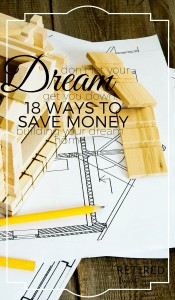This year may well give way to one of our family’s biggest adventures yet: building a house.
It all depends on how the house search goes: whether or not we can find a fixer-upper or move in ready house in our price range, whether a great piece of property becomes available, and so on and so forth. Also dependent upon what we do is how much private/public school is going to cost us.
We still have a lot most questions than answers when it comes to buying a home and moving, but one possibility we’re seriously considering is building a house.
We’ve already had a couple of conversations with a builder we trust, getting an idea of costs so we’re not blindsided if building ends up being our only option.
Basically, building a house is expensive, but out of that expensive, stressful process, you get a house that you designed, that you love, and that you’ll hopefully live in for quite a long time.
After our conversation with the builder, I got to thinking about how we could possibly save money building a home, and so I called him up and asked his opinion. Surprisingly, he was really helpful and gave me some ideas to use!
So, if you’re getting ready to build a house, thinking about building a house, or just curious, listen up! This is straight from the builders’ mouth!
1. Visit Lots of Homes
Plan to spend several weekends driving around and touring homes. Take pictures, make notes about what you like about them, what you don’t like, and how you feel about the construction. Deciding to change things halfway through are the single most expensive mistakes most people make. Even if you’ve already decided on your builder, tour model homes by lots of different builders. it is YOUR house and the builder works for YOU so don’t be afraid to ask for features that their competitors are including in their homes.

2. Utilize Design Books
You know that beautiful display racks of home books at Home Depot and Lowe’s that are so tempting to just throw in your cart while you’re there. Don’t do it. Those books are $20 – $30 bucks a pop and so not worth it. To take full advantage of the awesome ideas in those books in your home design, get them from the local library. Most libraries have more of those books and magazines than you could ever get through, and they’re completely free. Basically awesome.
3. Decide What Is Important To Your Early On
And stick with it.
Have tons of conversations with your spouse before you even meet with an architect to decide what style, colors, and features speak to you. Decide on a style early on and don’t switch it based on a whim, because changing up your design can be incredibly costly.
4. Settle On The Right Lot
Choosing the right lot is, obviously, the foundation for a successful home build. You may want to get a jump on building as soon as you find a potential lot, but do you homework. Find out where the city water and sewer hookups are, find out how much it will be to connect the utilities to your house, and if the property floods. If you don’t yet have a lot in mind, set alerts with an app on your phone to be notified when new listings become available to keep all of your options open.
5. Take a Good, Hard Look At Your Budget
Take stock of your finances: net worth, income, expenses, investments, and even debt before you even meet with an architect or builders. Determine exactly how much you can afford to spend based on the down payment you have saved, and the monthly payment (based on current interest rates). It may also benefit you to take a look at your debt to income ratio and see how much your bank will approve you for. If you don’t know, a quick phone call should yield you a quick result.
If you and your spouse are not a 100% comfortable with an amount that will allow you to build your dream home, then find ways to cut your budget, lower your debt, or even make extra money. You could even consider upping your down payment to make the monthly payment a bit more comfortable.
If you don’t know where your budget stands, I highly suggest you check out Personal Capital. Personal Capital is very similar to Mint.com, except it gives you way more information and is much easier to use. Personal Capital allows you to aggregate your financial accounts so that you can easily see your entire financial situation. You can connect accounts like your mortgage, bank account, credit cards, investment & retirement accounts, and more. Even better, Personal Capital is FREE.
6. Find the Architect That Speaks To You
Think of your architect like your doctor. You want one that is thoughtful, takes the time to listen to everything you have to say, and shows that they are competent and thoughtful.
If we decide to build, the hubs and I know that he has vision (he can visualize what something is going to look like) and I absolutely do not. Make appointments with several architects, explain to them the feel of what you’re looking for or even specific ideas you want to incorporate and ask them their feelings about designing that type of home. If you really want to get a feel for them – and you’re truly tryiing to save money on your custom home, ask them if you can discuss fees.
Often, the right architect for you will not have the lowest fees, but the added cost will be 100% worth it in the end.
7. Hire The Builder That Actually Listens To You
Oncce you’ve decided on your architect and have most of the design for your house done, you will need to find the right builder. One known for the quality of their work, for humoring stress-ed out clients, and who have a great working relationship with your architect. The best place to start this search is actually with your architect. Just like your would ask your primary care physician for a referral to a specialist, many times your architect will have a working list of builders they recommend.
Start with this list and do some internet research to see what people are saying about them. If all is well, ask to set up a meeting and see if they listen to you, if they’re flexible, and if they understand if you do/do not have trouble visualizing the finished product.
Above all, DO YOUR RESEARCH! Ask to see examples of homes they’ve built, talk to past clients, and get absolutely everything in writing. If you don’t protect yourself, contractors and their subcontractors can be horrible, so make sure that you’re protected!

8. Bid Out The Job
Even if you’ve settled on a builder you really like (or are required to use because of the subdivision you’re in) shop your blueprints around for bids. Even if you don’t change builders, this can be good for a couple of reasons.
First, if your builder came in much higher than the other bids, ask both builders why. Maybe the building materials are subpar, or maybe your builder is just trying to make more money off of you. If you’ve picked the right builder for you and your family, they will be willing to have an open and honest conversation about price.
Second, if your builder came in lower, you can also ask them why. This is honestly a red flag, and again, the right builder will be able to explain, in detail, why their price is what it is. If they feel at all slimy to you during this process, get out!
It is much better to take your time and find the right builder than to try and get through a horrible building process with a bad builder.
9. Shop Out Your Mortgage
Financing a new build isn’t always the easiest of processes.
Chances are, if you’re thinking about building a house, then you already have a bank in mind to finance the build. If you don’t, then consider using an online service like Lending Tree to shop around for the best rates.
Even if you really want to stick with your bank or credit union, still shop around for the best rate. If other lenders come up with better rates than your bank, bring those rates back to them and ask them to compete. Rather you like it or not, if your bank will not come down with their rate, you need to be prepared to switch. Even a 0.25% rate difference could save/cost you thousands of dollars over the course of a 30 year mortgage.
Just so you know, most builders will require a sizeable cash down payment, usually about 10%, and once that is paid will be constantly handing you invoice to turn over to your bank. Be prepared for this down payment and keep these invoice organized. Misplacing even one could be disastrous when it comes to completing the finances.
10. Shop For Fixtures/Features/Extras On Your Own
The price of everything is negotiable. Want a specific tile? Check ebay or Amazon before agreeing to the builder’s price.
Have specific hardware or cabinets in mind? Check local discount cabinetry stores to see if you can save some extra money. Often, if you find cabinet at a discount retailer, your builder will come pick them up for you, saving you the hassle. This alone could yield you significant savings in only a few minutes of your time.
11. Keep an Eye on Hardware Store Sales
From the time you decide 100% to build your next house, and have solidified the “style” you’re going to go with, you can start shopping the sales at your local hardware store for things like lighting, fans, even clearance on things like tile, shower heads, and more!
12. Use Coupon Codes
Find something you love at a discount online? Before hitting “Place Your Order” open a new browser tab and search for coupon codes for that website. Often you can find one that gives you an additional discount on top of the already low price, but even if you can’t, 99% of the time you’ll be able to score free shipping.
13. Don’t Be Afraid of a Little DIY
Often, if you can’t find the exact cabinets and doors you want completely finished, you can find them unstained. Cans of stain are insanely cheap, and apply stain to wood isn’t that difficult. If you’ve never stained before, consult YouTube or a friend who knows how before venturing out on your own, or if you don’t feel like getting that adventurous, find a family member or friend who knows what they’re doing and pay them a few hundred dollars to do the job right.
14. Take Advantage of Family
My father-in-law is a contractor, and I’m guessing that most people have someone in the family with some sort of licensing that gets them a contractors discount somewhere. At the hardware, paint, and plumbing store, my father in law gets significant discounts, and when we build we plan on using them as much as we can!
Use this discount for things like appliances, really good paint, and more.
However, don’t just assume that the discount is the best price. Often it doesn’t apply to clearance items, and by shopping around online you can often find a better deal.
15. Feed Your Friends
Have handy friends? Hire the to help you out! We have a builder friend, a friend who build his own house, a plumber, a counter tops guy, a tile guy, and even a concrete guy, and I bet if you looked around amongs your family, friends, and church you can find people who do many of those things. Ask them to put in a bid on the jobs they’re comfortable with and go with them if you can. Often, you’ll get a family & friends discount – just don’t forget to feed them in thanks for all of their hard work!
16. DIY
If you’re comfortable with certain products, make it clear to your builder that you intend to complete them yourself. For instance, the hubs and I have hung cabinets 4 or 5 times in the Father in law’s rental houses, and we’re actually pretty good at it! I lay tile like a pro (thanks to my father in law’s patient instruction) and together the hubs and I can lay hardwood floors like we were born to.
BUT, don’t take on more than you can handle, and definitely make sure you clear to start the projects you’ll be doing with your builder. You don’t want to lay tile before the floor is ready, hang cabinets before the wiring is done, or anything else that will actually COST you money in the long run.
17. Take Advantage of Tax Credits
Because of all of the emphasis on eco-friendliness, there are quite a few tax credits out there for energy-efficient home upgrades, and you can take advantage of them whether you’re building, buying, or just upgrading the features of your current home. I won’t list them here because they change each year, but do your research and/or ask your accountant and take advantage
18. Collect Boxes
When we moved last time (and we’ll do this the next time we move) we didn’t spend money on boxes for the move. Instead, I started bringing home the boxes they were going to just throw away from the restaurant I was working at. When those ran out, I scoped our our local grocery and dollar stores, who were more than happy to give us as many boxes as we could handle.
But the best boxes, by far came from McDonalds. Granted, they smelled like fried food, but they were really good quality, heavy boxes that we could fill to the brim with books and they wouldn’t break. Plus, our local McDonald’s was more than happy to tell us what days their trucks came in and what times were best to stop by for first pick at boxes.
We moved in beer boxes, but those boxes were free.
Building a custom home does cost significantly more than buying an older home, but the hope is that you’ll have built your perfect home, and that you’ll never want to move.
So, don’t be afraid to ask for exactly what you want – including all of these methods to save money. If you’ve chosen the right builder, they will be happy to accommodate you. If they balk, move on.
Above all, if you feel there is even the slightest chance of the new home becoming a financial strain, either don’t do it, or put off the build for a while. The ability to actually enjoy your home once its ready is paramount to making the stress of building a custom home worth it!
Have you considered building a home? Share your best advice with us!

P.S. If this post helped you, share it on Facebook, Twitter or Pinterest for an entry into this month’s giveaways!
a Rafflecopter giveaway
This post may contain affiliate links. See my disclosures for more information.













I am glad you mentioned getting design books from the library to use. My parents are planning to build their own custom home next year. Thanks for the tips on saving money building your dream home.